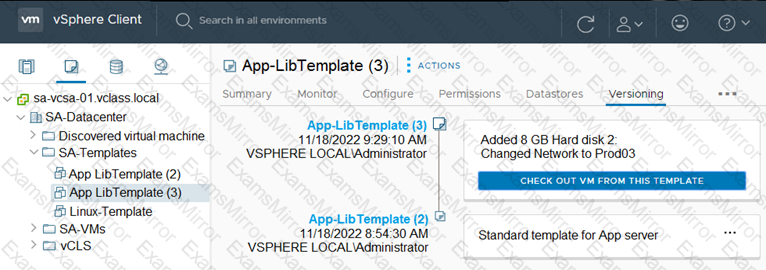Cyber Monday Special Limited Time 70% Discount Offer - Ends in 0d 00h 00m 00s - Coupon code = getmirror
Pass the VMware VCP-DCV 2023 2V0-21.23 Questions and answers with ExamsMirror
Exam 2V0-21.23 Premium Access
View all detail and faqs for the 2V0-21.23 exam
670 Students Passed
91% Average Score
92% Same Questions
What are two use cases for VMware vSphere+? (Choose two.)
An administrator is tasked with configuring an appropriate Single Sign-On (SSO) solution for VMware vCenter based on the following criteria:
• The solution should support the creation of Enhanced Link Mode groups.
• All user accounts are stored within a single Active Directory domain and the solution must support only this Active Directory domain as the identity source.
• All user account password and account lockout policies must be managed within the Active Directory domain.
• The solution should support token-based authentication.
Which SSO solution should the administrator choose based on the criteria?
An administrator needs to update a VMware vCenter instance to a newer minor release version. Due to restrictions within the environment, the vCenter instance does not have access to the Internet As a first step, the administrator downloads the required update on another machine.
What are the next steps the administrator must perform to complete the update?
A Place the update ISO file in a Virtual Machine File System (VMFS) datastore.
' Use the vSphere Client to select the update ISO file as the source for the update.
An administrator is tasked with applying updates to a vSphere cluster running vSAN using vSphere Lifecycle Manager. Downtime to the ESXI hosts must be minimal while the work Is completed.
The administrator has already completed the following steps and no errors have been returned:
• Downloaded all applicable software and created a new Image
• Attached the new Image to the cluster and run a compliance check against the Image for the cluster
• Ran a remediation pre-check for the cluster
Which two series of steps should the administrator perform to start the remediation of the cluster using the new image? (Choose two.)
Refer to the exhibit.

Given the configuration shown in the exhibit, what should the administrator do if the latest VM template contains changes that are no longer needed?
Which three features are only available when using vSphere Distributed Switches instead of vSphere Standard Switches? (Choose three.)
Which feature would allow for the non-disruptive migration of a virtual machine between two clusters in a single VMware vCenter instance?
An administrator notices a performance issue in VMvvare vCenter To try and understand more about the performance issue, the administrator needs to gather more information about the vCenter database to eliminate a potential disk space issue.
Which two tools can the administrator use? (Choose two.)
To keep virtual machines (VMs) up and running at all times in a vSphere cluster, an administrator would like VMs to be migrated automatically when the host hardware health status becomes degraded.
Which cluster feature can be used to meet this requirement?
Which VMware offering will allow an administrator to manage the lifecycle of multiple vCenter Server instances in a single software as a service (SaaS)-based solution to help drive operational efficiency?
TOP CODES
Top selling exam codes in the certification world, popular, in demand and updated to help you pass on the first try.
